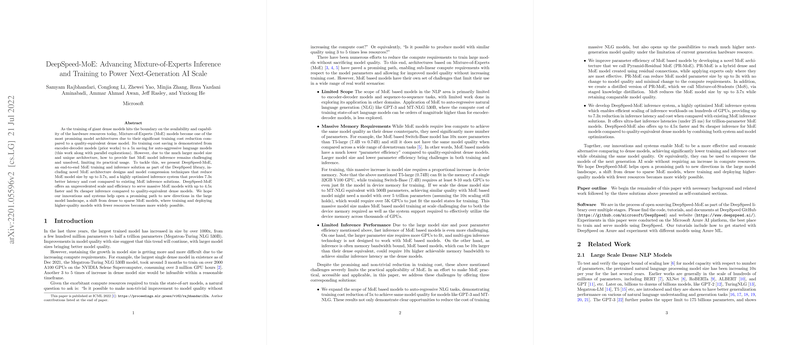Overview of DeepSpeed-MoE
Mixture-of-Experts (MoE) models have risen as a prominent architecture to address the increasing demand for model quality without proportional increase in training costs. These models, however, confront substantial challenges particularly in terms of inference due to their massive parameter count and unique architecture traits. The paper introduces DeepSpeed-MoE, a comprehensive solution that significantly enhances the efficiency and scalability of inference for MoE models as part of the DeepSpeed library.
Innovating Model Architecture and Training
Research has demonstrated that MoE models can drastically reduce training costs by 3 to 5 times over traditional dense models while maintaining comparable quality. The paper forwards this with the introduction of Pyramid-Residual MoE (PR-MoE), a new MoE architecture that cleverly uses residual connections and distributes experts more effectively across the model. This innovation reduces the parameter count by up to threefold without compromising model quality. Furthermore, the paper investigates a new technique called Mixture-of-Students (MoS), where PR-MoE serves as a teacher model for smaller-sized student MoE models, leveraging knowledge distillation to achieve up to 3.7 times reduction in model size while preserving model accuracy.
Reimagining MoE Inference
When it comes to inference, MoE models face performance challenges stemming from their larger memory requirements. DeepSpeed-MoE overcomes this by deploying a highly optimized inference system that realizes superb scaling across GPUs. The system is capable of offering up to 7.3 times reduction in inference latency and a significant cut in cost compared to existing MoE solutions. This results in ultralow latency for trillion-parameter MoE models, making massive MoE models viable for real-world applications.
Implications and Future Directions
This comprehensive approach to enhancing MoE models for both training and inference could set the stage for next-generation AI scalability. With systems like DeepSpeed-MoE, larger and higher-quality models can be developed and deployed using less computational resources, thus broadening the horizons for AI research and application. This moves the AI field towards more efficient and economical alternatives, as experts anticipate further innovations in large model landscapes, transitioning emphasis from dense to sparse MoE models.
The research, code, and tutorials for DeepSpeed-MoE are available online, and experiments have been conducted on Microsoft Azure AI platform, inviting wider community participation in advancing this domain. The improved parameter efficiency, scale, and reduced inference costs presented in this work underscore a significant step forward in operationalizing gargantuan MoE models for practical use, promising advancements in AI capabilities without the corresponding increase in computational demands.
